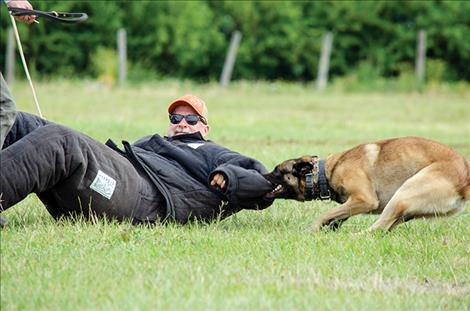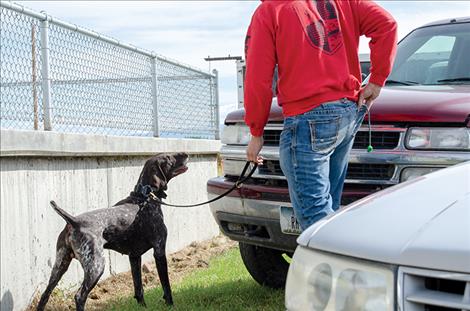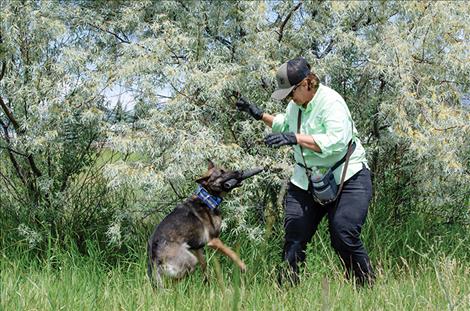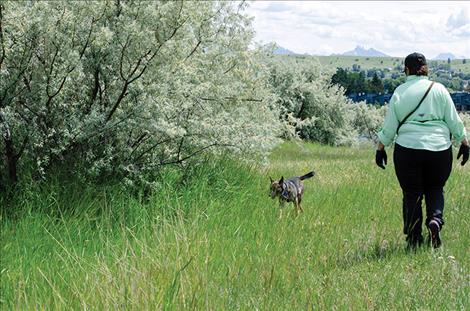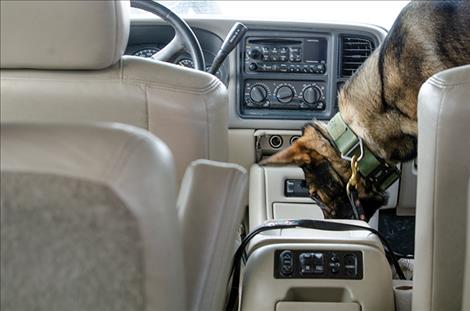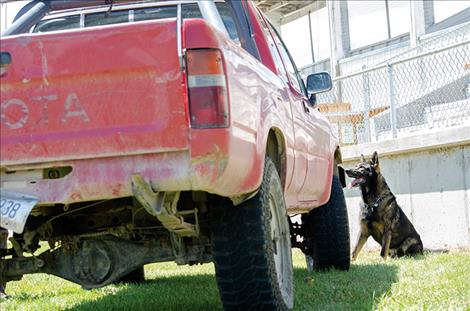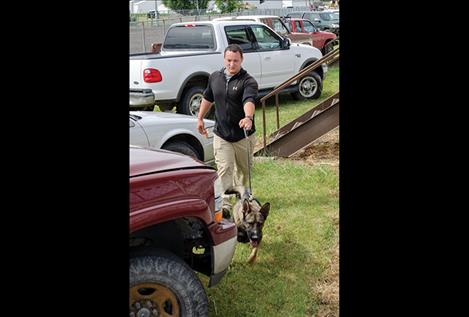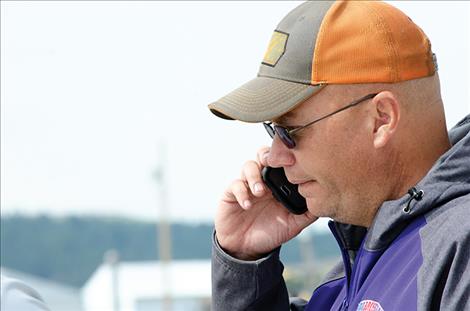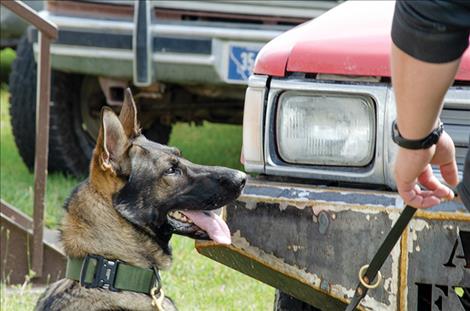K-9 officers find drugs at the fairgrounds during training
Hey savvy news reader! Thanks for choosing local.
You are now reading
1 of 3 free articles.
POLSON – Cocaine’s chemical smell filled the air from somewhere inside of a vehicle. A K-9 officer followed his nose and quickly moved to find the source. His handler watched anxiously. If the dog didn’t find the drugs, it could mean failure.
Forty police dogs and their handlers from all over Montana gathered at the Polson Fairgrounds to test their skills during the North American Police Work Dog Association certification course last week.
To be certified, the dogs need to take and pass the test once a year. One of the national certification tests was held in Polson for the first time ever last week. Certification is focused on skills including obedience, narcotics detection, tracking, building search, finding human remains, apprehension and explosives. Dogs only test for the skills they are trained to do. The course lasted for three days, starting on June 24.
According to NAPWDA, valid certification benefits the officer when giving court testimony and making apprehensions and eliminates the liability of poorly trained dog teams. Only an accredited NAPWDA Master Trainer can certify a K-9 team after they complete the test. The accredited trainers and master trainers consist of current or retired law enforcement.
During the narcotics detection test at the fairgrounds, 12 vehicles were parked along the bleachers. Ronan Auto Sales supplied the vehicles as training aids. Drugs like heroin, methamphetamines and cocaine were hidden in the cars. The Drug Enforcement Administration provided the drugs in five-gram increments.
During the narcotics test, each handler and dog team waited for the master trainer to tell them to begin. While on a leash, the dog circled each vehicle using powerful senses. They needed to make eight finds.
Shad Andersen, sergeant for the Montana Western Criminal Interdiction team with the Montana Highway Patrol, organized the Polson event. He explained that scientists think a dog’s sense of smell is 100,000 times more powerful than humans, which is why they are a great resource for law enforcement. “Dogs are an invaluable tool,” he said.
Scott Sciaretta with the Lake County Sheriff’s Office K-9 Unit also helped organize the event. He said, depending on training, a dog would alert when it finds drugs by sitting down or putting its nose as close as possible to the scent.
Rob Hickman, NAPWDA master trainer and vice president, watched the dogs circle the cars during the training. He said for narcotics certification, a team is permitted to miss only one find or they fail. He said a dog isn’t looking for the drugs due to an addiction of any kind. “They do this because they want their toy,” he said.
After making a find, the officer throws out the dog’s special toy and the fun begins. The officer uses positive reinforcement with a high-pitched
voice saying “good job” and the dog rolls around with the toy, enjoying the reward.
If a team fails the course, they can try again. “We don’t see failure very often,” Hickman said. “When we do, it’s most often from certification pressure.”
If they fail a second time, the team is usually done. The handler will get a different dog, more training or consider that K-9 work is not a good fit. “We want good dogs and good teams,” he said.
Another issue that often happens is that the handler tries to do the work by leading the dog where it needs to go. The officers have to learn to trust the dog’s senses and let up on the leash, he said.
At another station, dogs were working to get certification to apprehend suspects. Master trainer Kevin Klostermeier was dressed in a padded canvas bite suit. He stood in an open field near the bleachers making loud noises and shooting off a pistol while a K-9 sat watching. The dog needed to demonstrate self-control and the ability to wait for the handler’s command. Once given the signal, the dog attacked.
“I can feel the pressure of the bite,” Klostermeier said, explaining that he wants to feel how the dog is working. If the dog makes several bites, corrections need to be made. The goal is to teach the dog to make one solid bit and hang on until being called off by the handler.
Klostermeier said the dogs participate in the apprehension work much like a human would a boxing match. The animal goes in and tries to get in a good punch, watching for submission from the opponent. “The dogs have a fight drive and they like combat. It’s enjoyable. After they are done, they don’t have anything against their opponent. It’s just fun.”
Bomb detection certification was being done in the arena at the fairgrounds. Tim Turner, master trainer, said the dogs needed to find 11 of the 12 training aids, including explosive powders. The dogs with this certification can detect the odor of explosive devices in things like luggage, buildings and open areas. Darren Ginn with the University of Montana police takes his dog through the football stadium and other venues to ensure public safety before events. He also gets called when there is a bomb threat.
Dogs trained to find human remains were working to get certified at a station along the Flathead River, near the fairgrounds. One of the dogs circled the field until catching a light breeze and finding an odor hidden up in a tree.
Master trainer Robert Noziska watched the dogs make sure they found 12 of the scents placed in the area, one of which were the human remains placed under water, although the finds buried underground were harder to locate because the scent doesn’t travel upward like it would in water.
“The dogs don’t have any politics or desire to do wrong,” he said. “They are working instinctually. The handler has to learn to trust the dog’s instincts.”
Julie Balch with the Flathead County Sheriff’s Office Search and Rescue team brought her dog to get certified. She said her dog had to work hard to find the human bone hidden in the tree. “The high wind made it tricky,” she said, “but I wouldn’t have it any other way. Working with a master trainer on these hard finds improves our skills and makes us better for the community.”
K-9 teams often have to travel long distances each year to attend training. Local law enforcement and search and rescue teams said they appreciated having the training in Polson with less travel for this year’s certification. The training continued into the next day with several staged scenarios where dogs made more finds. Anderson thanked the master trainers for traveling to Polson to help the teams get certified.















